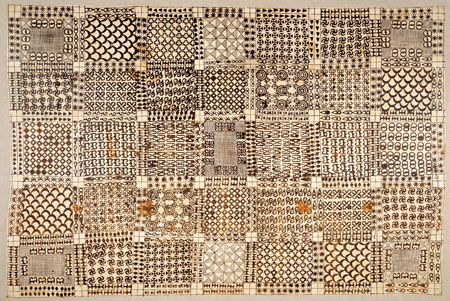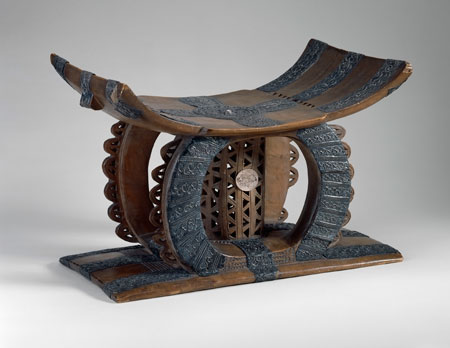
Wrapper
Asante peoples, Ghana
Mid- to late 19th century
Imported cotton cloth, black pigment
National Museum of African Art, museum purchase, 83-3-8
A constellation of symbols. In this rare adinkra cloth, clusters of crescent moons and stars join a host of "terrestrial" motifs to communicate strength and resiliency in the face of upheaval. Asante king Agyeman Prempeh I (ruled circa 18881931) wore this cloth in January 1896 to meet with British authorities, where he was arrested, deposed, and exiled to Sierra Leone and later to the Seychelles.
Eighteen symbols decorate the cloth that Prempeh wore that fateful day. They communicate his power as well as his awareness that the British threatened his reign and the kingdom. The stars refer to the reliability of the king, who is more constant than the changing phases of the moon. Motifs along the central block include:
Double curve ram's horns, which symbolize leadership, strength, and humility, and evoke the proverb, "When the horns of two rams clash in a fight, one must give way to another."
Dono drum, played at royal processions to denote authority.
"Castle" and "wind house," emblems of the strength and resiliency of the Asante nation during stormy, unsettling times.
To those familiar with its graphic language, this constellation of symbols signaled the king's recognition that his control of the kingdom was in peril, but the Asante nation would endure beyond this difficult moment in their history.
|

Owusu-Ankomah
b. 1956, Ghana
Starkid
2007
Acrylic on canvas
Collection of the artist and courtesy October Gallery, London
What can they be thinking? In Starkid, Owusu-Ankomah captures a sense of wonder and speculation about the celestial firmament and our place in the world. Each figure concentrates on a glowing orb, yet their observations are both solitary and shared.
The artist locates three powerfully rendered human forms against a lively backdrop of personal symbols and those drawn from the lexicon of traditional adinkra motifs from his homeland of Ghana. Thickly applied black acrylic paint visually refers to the tar-like pigment that adinkra specialists use to stamp their designs.
|

Crown
Akan peoples, Ghana
c. 190050
Velvet, wood, gold leaf
Museum of Fine Arts, Houston, gift of Alfred C. Glassell, Jr., 97.891
Down-to-earth celestial messages. An Akan chief's crown is ornamented with gold celestial symbols linked to political power and to sayings about wise leadership and appropriate behavior within the community. The star, a "child of the sky," recalls a proverb on the importance of faith and reliance on others: "Like the star, the child of the Supreme Being, I rest with God and do not depend upon myself [alone]." The crescent moon is a feminine symbol associated with faithfulness; when combined with a star, the design conveys the interdependence of men and women in marriage. The juxtaposition also refers to the king's reliability, who as a star is more constant than the changing phases of the moon.
|

Royal stool, rainbow motif
Asante peoples, Ghana
c. 1860
Wood, silver repoussé
The Nelson-Atkins Museum of Art, Kansas City, Missouri; purchase: William Rockhill Nelson Trust, 65-5
If rainbows could speak. A celestial phenomenon that inspired Akan stool carvers, as well as those with a flair for proverbial sayings, is the rainbow (nyankonton). "The rainbow is around the neck of every nation" emphasizes the king's mission to unite the Asante chiefdoms and to care for the state and its people. Another proverb uses the rainbow's gradual dissipation in the sky to urge acceptance of one's fate.
Among Ghana's Akan peoples, including the Asante, the stool symbolizes royal authority and is a personal object connected to the soul of its owner. This stool, believed to have belonged to the Asante king Kofi Kakari (18371884), was confiscated from his palace by British colonial authorities in 1873.
|
 "Like the star, the child of the Supreme Being, I do not depend upon myself [alone]" encourages reliance on others.
"Like the star, the child of the Supreme Being, I do not depend upon myself [alone]" encourages reliance on others. The crescent moon is a feminine symbol for faithfulness. When combined with a star, it conveys the interdependence of men and women in marriage. In leadership regalia (look closely at the adinkra cloth and crown below), the symbols suggest the reliability of the king (the star) confronting changing forces (lunar phases).
The crescent moon is a feminine symbol for faithfulness. When combined with a star, it conveys the interdependence of men and women in marriage. In leadership regalia (look closely at the adinkra cloth and crown below), the symbols suggest the reliability of the king (the star) confronting changing forces (lunar phases). "The rainbow is around the neck of every nation." This proverb emphasizes the reach of a powerful ruler, as suggested by the bowed supports of the royal stool. The rainbow's gradual disappearance urges acceptance of one's fate.
"The rainbow is around the neck of every nation." This proverb emphasizes the reach of a powerful ruler, as suggested by the bowed supports of the royal stool. The rainbow's gradual disappearance urges acceptance of one's fate.


